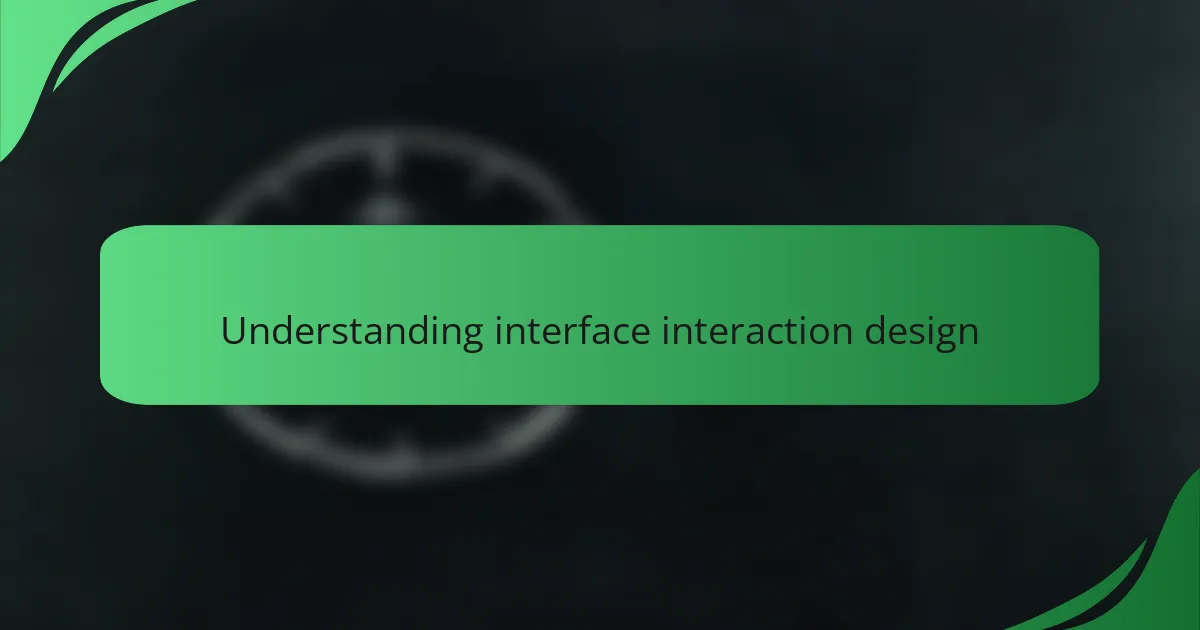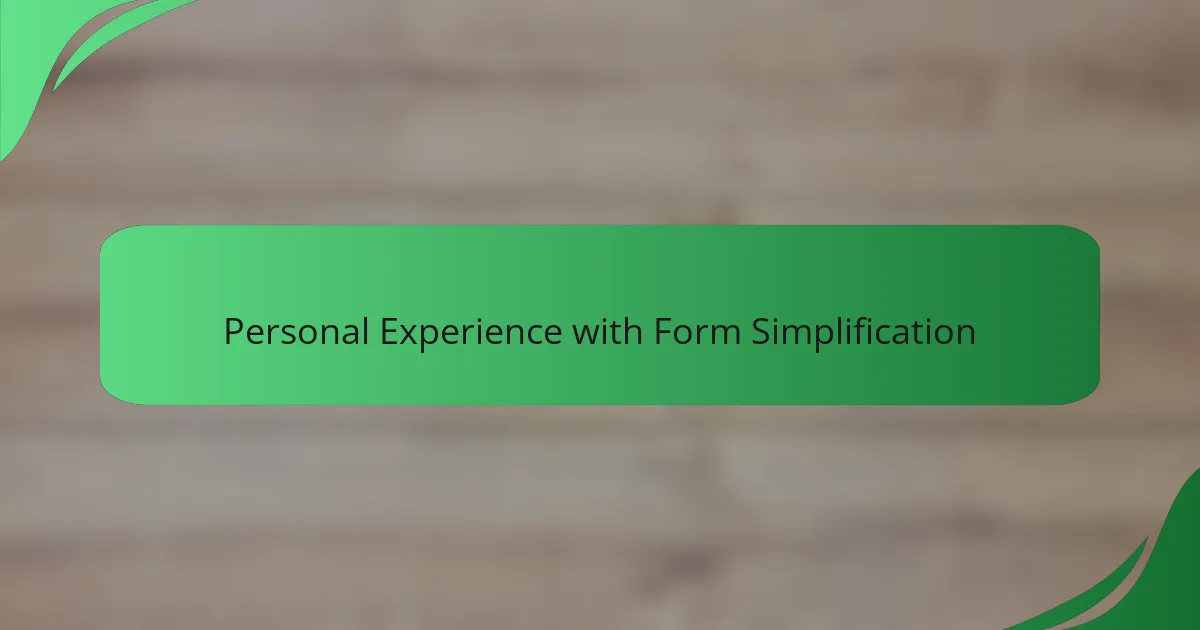Key takeaways
- Simplifying forms by minimizing input fields and using clear labels significantly enhances user experience and satisfaction.
- Incorporating real-time validation and visual cues improves usability, reducing frustration during form completion.
- Mobile optimization is essential, as poorly designed mobile forms can lead to high abandonment rates and user frustration.
- Empathy in design, anticipating user needs, can create smoother and more inviting interactions with digital products.

Understanding Interface Interaction Design
Interface interaction design is all about creating seamless experiences that connect users with digital products. From my experience, it’s vital to think about the user’s journey and the emotions they feel while navigating a site. I remember redesigning a form on my own website; the change in user engagement was remarkable once I focused on simplifying the process.
One thing to keep in mind is that effective interaction design isn’t just about aesthetics; it’s about functionality. Users appreciate a design that feels intuitive. Here are some key factors to consider:
- Prioritize clarity: Use simple language and avoid jargon to make forms accessible to all users.
- Minimize input fields: Each additional field can feel daunting. Only ask for what you really need.
- Provide real-time validation: Let users know immediately if they’ve made a mistake, which saves frustration.
- Use visual hierarchy: Organize information logically, guiding users through the form with clear sections and labels.
- Include helpful prompts: A little guidance can go a long way in easing user anxiety.

Importance of User Experience
User experience (UX) is crucial because it directly impacts user satisfaction and engagement. I recall a time when I revamped forms on a website, and the positive feedback was overwhelming. Users appreciated how streamlined the process was, which made their interactions feel effortless.
Good UX can turn a one-time visitor into a loyal customer. I’ve seen firsthand how minor adjustments can lead to a significant increase in conversion rates. It’s often the small details that make users feel valued, like ensuring forms are intuitive and visually appealing.
Here’s a comparison table highlighting simple form design versus complex form design in terms of user experience:
| Aspect | Simple Form Design | Complex Form Design |
|---|---|---|
| User Satisfaction | High | Low |
| Completion Rate | Increased | Decreased |
| Time to Complete | Shorter | Longer |
| Visual Appeal | Clean & Organized | Cluttered |

Key Principles for Simplifying Forms
One of the key principles I’ve embraced is prioritizing clarity. When I simplified forms on my website by using straightforward language, I noticed users responded positively. It made me realize how jargon can create barriers, making users feel lost or confused.
Minimizing input fields is another effective strategy. Each extra field can feel like a hurdle, and I’ve seen firsthand how this can deter users. When I trimmed down my forms to the essentials, it was like lifting a weight off my users’ shoulders, making them more inclined to complete the process.
Real-time validation has transformed the way users experience forms. In the past, I would get frustrated by errors that went unnoticed until the final submission. Implementing instant feedback made a huge difference; users now receive gentle nudges instead of waiting until the end, leading to a smoother, more enjoyable interaction overall. Isn’t it amazing how small adjustments can significantly enhance user satisfaction?

Techniques for Effective Form Design
When I began refining my approach to form design, I quickly learned that simplicity is key. Long forms can overwhelm users, causing frustration and abandonment. By breaking down the process into smaller, more manageable sections, I noticed an increase in completion rates. For example, instead of asking for a myriad of details all at once, I like to use a step-by-step approach, which feels less daunting. This shift not only improved the user experience but also made my designs feel more inviting.
There are several techniques that can enhance form design and make it more user-friendly:
- Limit Fields: Only ask for essential information to minimize cognitive load.
- Use Clear Labels: Ensure labels are straightforward and self-explanatory to guide users effectively.
- Group Related Fields: Organizing fields into logical sections helps users process information better.
- Provide Real-time Validation: Instant feedback on entries improves accuracy and reduces frustration.
- Incorporate Visual Cues: Use icons or color changes to highlight errors, making it easier to correct mistakes.
- Utilize Placeholder Text: Provide examples of expected input, which can clarify the information needed.
- Design for Mobile: Optimize forms for smaller screens, ensuring users on all devices have a seamless experience.

Common Mistakes in Form Design
Designing forms is always a balancing act, but I’ve often seen common mistakes that can derail the user experience. One of the biggest pitfalls is asking for too much information upfront. I’ve personally encountered situations where I clicked away from a form that looked more like a marathon than a sprint. Just imagine: you’re eager to sign up for a newsletter, but the long list of requirements makes you second-guess your decision. It’s vital to keep it short and sweet.
Another common mistake is neglecting to offer visual feedback. I vividly recall a frustrating experience attempting to fill out an online form that didn’t indicate errors until the end. When I flipped that on its head in my own designs, incorporating real-time validation became a revelation. Users expressed relief at being guided throughout the process, as it kept their anxiety levels at bay.
Also, I’ve noticed that many designers overlook the importance of mobile optimization. It’s 2023, and we’re all on the go! I’ve been in situations where a poorly designed mobile form made me feel like I was wrestling a bear. User frustration skyrockets when forms aren’t responsive, leading to abandoned submissions. Making form designs mobile-friendly isn’t just a nice touch; it’s essential for a positive experience. Why not think about how your users interact with your forms on their devices? It can make all the difference.

Personal Experience with Form Simplification
When I first started designing forms, I would often overwhelm users with lengthy fields and complicated layouts. I remember a project where a client required a complex registration process. After watching users struggle and get frustrated, I decided to simplify the form by reducing the number of required fields. This change not only improved the completion rate but also created a smoother experience for users, making them feel more at ease while interacting with the site.
My approach to form simplification goes beyond just reducing fields; it’s about empathy. I strive to anticipate user needs by incorporating the following strategies:
- Limit Required Fields: Only ask for essential information to reduce cognitive load.
- Use Clear Labels: Ensure every field is easily understandable, minimizing potential confusion.
- Progressive Disclosure: Group information logically; show only what’s necessary and reveal more as needed.
- Positive Feedback: Provide real-time assistance through inline validation or helpful tips.
- Mobile Optimization: Design forms that are easy to fill out on any device, catering to the user’s convenience.
I truly believe that every improvement in usability can significantly enhance the overall user experience, making it a win-win for both the users and the designers.




